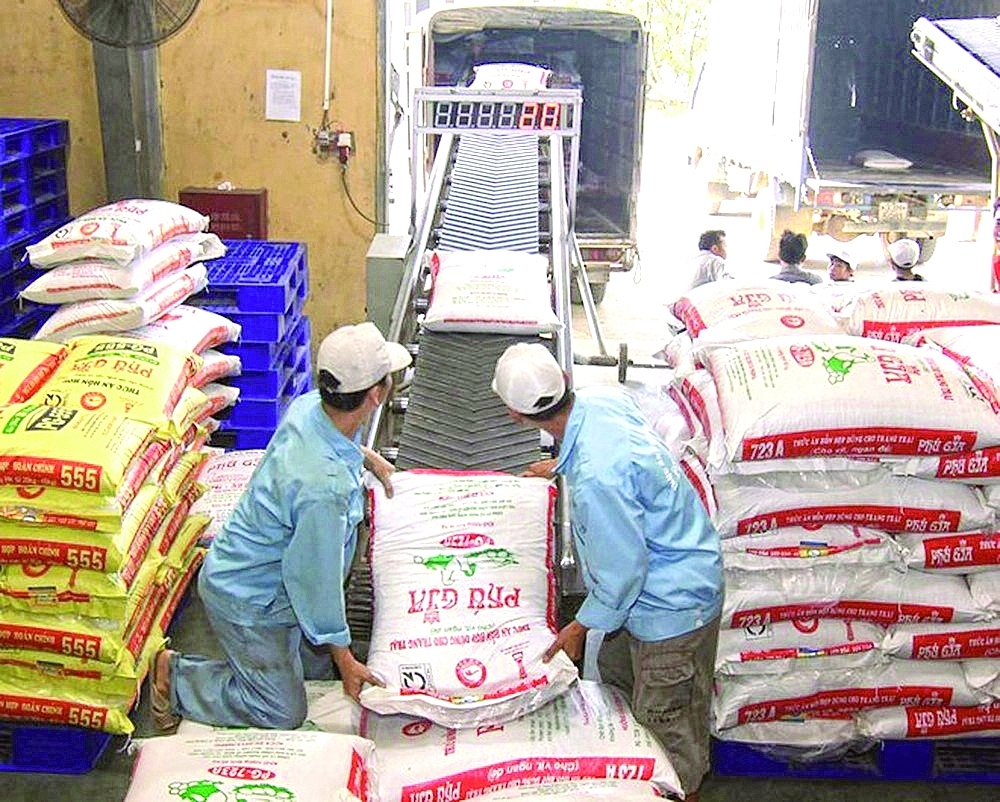Reduce import of raw materials to stabilize animal feed market
| Agriculture, aquaculture firms focus on growing their own raw materials | |
| Completing policies to effectively manage mineral resources | |
| Food industry changes drastically amid pandemic |
 |
| It is forecasted that the price of finished feed products will increase at least 5-10%. Photo: ST |
Imports increased by more than 6% per year
According to the Department of Livestock Production (Ministry of Agriculture and Rural Development), the total amount of raw materials for animal feed imported in 2015 was 15.4 million tons (equivalent to US$5.3 billion). By 2020, the import volume will increase to 20.2 million tons (equivalent to US$6 billion). The annual average growth rate in the 2015-2020 period is 6.2% / year (equivalent to a growth rate of domestic feed production of 5.7% / year).
In the first quarter of 2021, the total amount of imported feed products reached 5.4 million tons, equivalent to US$1.66 billion, up 3.94% in quantity and 5.53% in value over the same period in 2020.
Regarding prices of raw materials and finished feed products in the country, Mr. Nguyen Xuan Duong, acting director of the Department of Livestock Production, said that in the period from 2015 to the third quarter of 2020, prices were generally stable, and even decreasing gradually. The prices of main feed ingredients started to increase from October 2020 and soared with an average increase of 30-35%.
However, the price of finished feed products only started to increase slightly from December 2020 (because in this period, enterprises still had low reserves of raw materials) and gradually increased.
From the first price increase at the end of 2020 to now, the price of finished feed products in the country has increased on average from 5-6 times (an increase of VND200-300 / kg / time), with a total increase of 10-15% (equivalent to VND1,000-1,500 /kg, depending on the type).
In the production of industrial feed, raw material prices usually account for about 80-85% of the production costs. Other expenses such as fuel, depreciation, labor, interest, salary account for about 10-15%.
The average cost of raw materials for complete mixed food for pigs is VND8,894 / kg. The average total mixed food for chickens was VND9,757 /kg. The average complete mixed food of white chickens is VND10,050 /kg. The operating costs of production, business, packaging, salary are about VND2,500-3,000 / kg.
"This leads to the actual selling cost of a complete mixed food of a fattening pig of about VND11,000 VND / kg; a complete mixed food of a fattening chicken is about VND12,100 / kg; A complete TAHH of a broiler white is VND12,500 VND / kg," Mr. Duong said.
The Department of Livestock Production assessed that the prices of key feed ingredients have not tended to decrease in the second quarter of 2021, and are expected to gradually decrease and stabilize from July 2021.
Accordingly, the price of finished feed products will increase, at least 5-10% (VND500-1,000 / kg) depending on the type, to reach an overall increase of 20% before it can be stopped.
At that time, the complete mixed food for broilers at the fattening stage may rise to over VND11,000-11,300/ kg and this is the price that was set in 2014.
Make the most of domestic ingredients
According to the leaders of the Department of Livestock Production, the price of imported feed ingredients as well as the price of finished feed products continued to increase because the prices of all grains on the world market increased and set a new price level.
This comes from the high production costs, climate change affecting crops, large investment funds turning to speculation in agricultural products and China increasing purchase of grain for production and animal domestic husbandry.
Another important factor is the impact of the Covid-19 pandemic, so transportation costs increase due to the lack of ships and general cargo containers, including feed products (average transportation costs increase by 200-300%).
Along with that, Argentina, which supplies a large amount of corn, soybeans and soybean meal to the world market, has protested and held strikes at seaports in January and February 2021, hindering the export of consignments have been signed with customers, including many Vietnamese enterprises.
To control feed prices and markets, Mr. Duong said that feed manufacturers and traders need to actively seek and make the most of domestic feed ingredients that can replace imported sources for processing (cashew nut oil, cashew bran, cassava residue, rice bran); balance the best diet; ensure good management of raw materials and minimize production costs to lower the cost of finished feed products.
In addition to actively sourcing raw materials, according to some experts, special emphasis should be placed on reducing the cost of importing feed ingredients with commercial policies and improving the logistics system capacity in import and export activities and trading feed ingredients.
From the enterprise's perspective, the representative of Vietnam Livestock Joint Stock Company said the enterprise's experience is to actively increase the reserve of raw materials for production, avoiding the situation of being "frozen" in the context of rising feed prices.
"Logistics needs to be smoother, reducing transportation costs of loading and unloading time in bulk. In fact, there are also many raw materials for animal husbandry such as fish processing by-products, shrimp, so make use of it. It should not be too dependent on imported materials,” he said.
The Department of Livestock Production recommends the Ministry of Industry and Trade to urgently conduct bilateral negotiations with countries where Vietnam imports a large amount of feed ingredients (USA, Argentina, Brazil, India) to have preferential policies on price, giving priority to meeting the quantity and ensuring the quality of feed ingredients for the market in Vietnam.
For the Ministry of Finance, the recommendation is to have a temporary policy to reduce import tax on maize, soybean meal and wheat in the short term; reducing fees for storage of imported feed ingredients; at the same time, allocating a budget to prioritize and simplify the process and procedures for the implementation of Decree 57/2018 / ND-CP of the Government on mechanisms and policies to encourage enterprises to invest in agriculture and rural areas.
Related News

Complying with regulations of each market for smooth fruit and vegetable exports
13:06 | 09/01/2025 Import-Export

Coconut export enter acceleration cycle
11:02 | 30/12/2024 Import-Export

Increasing consumption demand, steel enterprises have many opportunities
07:43 | 31/12/2024 Import-Export

The Middle East: a promising seafood export market for Vietnam
07:43 | 31/12/2024 Import-Export
Latest News

Freight transport via China-Việt Nam cross-border trains posts rapid growth
08:01 | 13/01/2025 Import-Export

Vietnamese retail industry expects bright future ahead
06:22 | 11/01/2025 Import-Export

Fruit and vegetable industry aims for $10 billion in exports by 2030
15:12 | 07/01/2025 Import-Export

GDP grows by over 7 per cent, exceeds target for 2024
15:11 | 07/01/2025 Import-Export
More News

Vietnamese pepper: decline in volume, surge in value
15:10 | 07/01/2025 Import-Export

Việt Nam maintains position as RoK’s third largest trading partner
15:09 | 07/01/2025 Import-Export

Greater efforts to be made for stronger cooperation with European-American market
15:08 | 06/01/2025 Import-Export

Leather, footwear industry aims to gain export growth of 10% in 2025
15:06 | 06/01/2025 Import-Export

Grasping the green transformation trend - A survival opportunity for Vietnamese Enterprises
14:53 | 06/01/2025 Import-Export

Việt Nam to complete database of five domestic manufacturing industries in 2026
20:57 | 05/01/2025 Import-Export

Logistics firms optimistic about growth prospects in 2025: Survey
20:54 | 05/01/2025 Import-Export

Vietnamese products gain popularity in the UK, EU
14:39 | 03/01/2025 Import-Export

Việt Nam set to become regional manufacturing tech hub this year
15:53 | 02/01/2025 Import-Export
Your care

Freight transport via China-Việt Nam cross-border trains posts rapid growth
08:01 | 13/01/2025 Import-Export

Vietnamese retail industry expects bright future ahead
06:22 | 11/01/2025 Import-Export

Complying with regulations of each market for smooth fruit and vegetable exports
13:06 | 09/01/2025 Import-Export

Fruit and vegetable industry aims for $10 billion in exports by 2030
15:12 | 07/01/2025 Import-Export

GDP grows by over 7 per cent, exceeds target for 2024
15:11 | 07/01/2025 Import-Export
